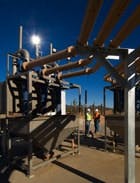Black & Veatch and McCarthy Building Companies, Inc. have announced that the Lake Pleasant Water Treatment Plant in Phoenix, Ariz., earned the 2008 National Design-Build Award from the Design-Build Institute of America (DBIA) in the “water/wastewater over $15 million” category.
The plant currently serves 400,000 customers with an initial treatment capacity of 80 million gal per day (mgd) and is expandable to an ultimate capacity of 320 mgd.
The Lake Pleasant Plant was completed for the city of Phoenix by the design-build-operate (DBO) team comprised of the Black & Veatch-McCarthy joint-venture design-build team and American Water Enterprises, Inc., a subsidiary of American Water, the largest investor-owned U.S. water and wastewater utility company.
Phoenix Councilman Claude Mattox, who serves as the vice-chair of the National League of Cities Energy, Environment and Natural Resources Steering Committee, congratulated the team on the accomplishment.
“Thanks to the efforts of the partners and our city engineers, this state-of-the-art water treatment plant will serve our growing community well into the future,” said Mattox. The new plant, which is the largest integrated DBO project in North America, was designed to blend seamlessly into the desert landscape without disturbing the natural beauty of the area. As a result, 95% of the habitat was preserved in its natural condition.
The plant incorporates the latest developments in modern water technology and automation, which will benefit the residents of Phoenix. The design-build process included sustainable features that lay the groundwork for future customer growth and development, expanded capacity and emerging treatment technologies. The team also successfully focused on developing the water treatment plant with streamlined, efficient operations.
“A key to the success in achieving our goals was to combine all resources under one roof, which enabled a collaborative work environment,” said Dave Mahaffay, senior vice president and west region managing director for Black & Veatch’s global water business. “All parties involved were focused on delivering the project on time and within budget, as well as on ensuring operational excellence in safety and construction management.”
According to Bob Knochenhauer, senior vice president of operations, water services, for McCarthy’s Southwest Region Water Services, “The team’s collaborative approach was critical to the effective management of each phase of this complex project. It allowed for construction to start two months ahead of schedule and a budget reduction of $30 million, positioning both the team and the community for success.”
The treatment process design incorporates seven independent barriers for pathogens, virus and bacteria removal while typical treatment plant designs incorporate three to four barriers. Selected water treatment processes—such as high-rate ballasted flocculation, ozone, granular activated carbon contractors and ultraviolet—achieve superior operating and cost efficiency with numerous inventive improvements specific to residents’ needs, the local environment and available resources.
The national award was presented at the DBIA Annual Conference and Awards Ceremony held recently in Las Vegas.
Source: Black & Veatch


